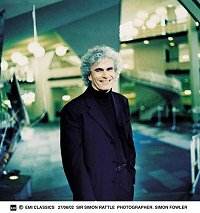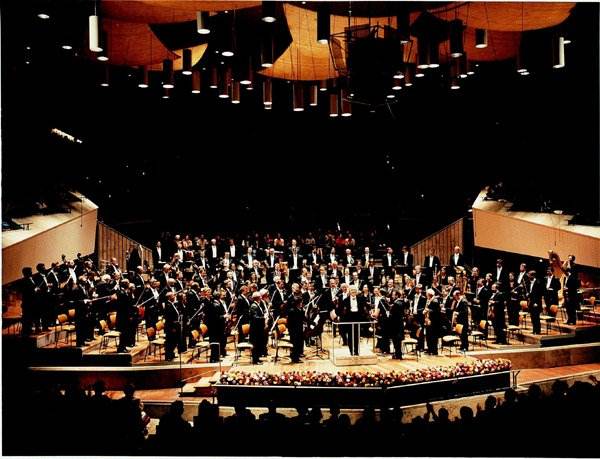S & H Concert Review
Haydn & Mahler: Berliner Philharmoniker, Simon Rattle. Royal Festival Hall, Saturday October 12th (ME)
Haydn, Symphony No.88
Mahler, Symphony No.5‘What can one play after Mahler’s Fifth?’ enquired Simon Rattle of the audience, after this stunning performance: ‘Play it again!’ someone yelled, to be greeted with cheering – and, had they done so, I am sure that very few of us would have wanted to move out of that hall, since we had just been privileged to experience performances of these two well-loved works which came as near to perfection as anyone can hope for on this earth.
Haydn’s 88th Symphony has been offered as an opener by just about every orchestra, but this was something else; from the very first bars, one was made aware of the truth of Rattle’s assertion that ‘...the level of ability is breathtaking, I mean almost vertigo – inducing.’ This is what classical (in the sense of 18th Century) orchestral playing should be about; elegant without coldness, glossy without superficiality, sparkling without triviality. Rattle inspired the players to achieve a wonderfully polished performance yet one that lacked nothing in feeling, an achievement best exemplified in the superb Adagio, which featured some stunning playing by the principal oboe (Albrecht Mayer, well known to those who have heard his wonderfully fluid accompaniment to Matthias Goerne’s Bach Cantatas) and the ‘cellos and double basses. The Trio’s bagpipe drones can seldom have sounded so rustic, and despite a rather surprising feeling of tentativeness from the higher strings at the start of the Allegretto, this was a performance of the 88th which would have delighted the ‘Great sovereign of the tuneful art.’

It was, of course, Mahler’s 5th Symphony that everyone had come to hear, and Rattle and the Philharmonikers did not disappoint. Every time I read an article, analysis or review of a performance or recording of this work, someone seems to be trying to persuade me that it was with this symphony that Mahler finally came out into the open (whatever that may mean), cast aside his wordy, poetic style and went for something akin to what might properly be called symphonic form; well, that always sounded bogus to me, since the 5th is just as gloriously word-bound as the 4th and the vocal works with orchestra, it’s just that the instruments, in this case most obviously the Horn, replicate the voice in every possible way, and it was the chief of the many glories of this performance that Rattle had understood this in such a way as no other Mahler conductor I have heard.The opening Trumpet fanfare was positively blazing, setting the scene for a ‘Trauermarsch’ that was utter perfection; yes, this is funereal music, but like the ‘Kindertötenlieder’ which it quotes, it is also meltingly tender in character, and the way in which the opening bars remained in one’s head throughout, the superb management of the rests, and the constant evocation of that pouring rain sound in the violins, so evocative of Keats’ phrase about being ‘drowned and rotted like a grain of wheat,’ were all absolutely searing. The second movement showed the orchestra reaching sublime heights; the biting edge of the percussion was especially remarkable here, as were the tautness maintained between the ethereal harp and the accompanying strings, and the almost painful tension of the conclusion.
The Scherzo, over which Mahler had agonized more than any other of his works to that date, showed that Rattle had understood what the composer wanted – ‘Every note is charged with life, and the whole thing whirls round in a giddy dance.’ Giddy it may have been at times, but it was also elegant when required, with some especially fine string playing (exquisite portamenti) in the waltzes, and the Horn ‘solo’ (Stefan Dohr) was played with serene mastery. Rattle had decided to follow the instructions given in Mengelberg’s full score, that the horn should be very prominent, with the soloist placed at the front, and it worked triumphantly; there was no sense of undue separation from the body of the orchestra, yet the horn was given its proper weight; it will be difficult to experience this movement in any other way from now on.
Everyone knows the ‘Adagietto,’ whether through its use in ‘Death in Venice’ or the romantic tale of how the composer used it as a wordless proposal to Alma, so its performance presents the special challenges raised by familiarity and expectation. This was not an unduly drawn out version – I made it just over nine minutes – yet the overwhelming sense of this ‘song without words’ was that of introspection, delicacy and tenderness without being cloying; I found it intensely moving, especially in the way Rattle managed the phrasing, so very song – like in its quality. What was even more remarkable was the way in which you were made to feel that this was not an isolated piece, but a part of a larger whole, and when the tremendous, shattering relief of the Finale came it was not as a sharp contrast but created a similar feeling to that which one gets as ‘In diesem Wetter’ begins after the brief sunlight at the end of ‘Oft denk’ ich, sie sind nur ausgegangen!’ – and that, I am sure, is precisely what Mahler wanted.
The closing bars of the Finale were simply overwhelming in their sense of release, with direction and playing of the most searing intensity, with every member playing as if possessed. A thunderous, heartfelt standing ovation followed and when the players remained seated when invited to take another bow, Rattle said ‘Well, if they won’t stand up, I suppose we’d better play something…’ and the ‘something’ was an exquisite performance of Satie’s ‘Gymnopédie’ which closed the evening in a state of authentic rapture.
Melanie Eskenazi

 Return to:
Return to: